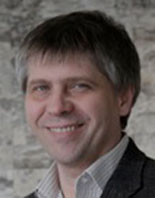 |
Chaired Professor (Åmnesprofessor), Dependable Computation and Communication Systems
|
Valeriy Vyatkin (M’03–SM’04) is on joint appointment as Chaired Professor (Åmnesprofessor) of Dependable Computation and Communication Systems at Luleå University of Technology, Sweden, and Professor of Information and Computer Engineering in Automation, Aalto University, Finland. Previously he has been with Cambridge University, U.K., as a visiting scholar, and on permanent academic appointments with The University of Auckland, New Zealand, Martin Luther University of Halle-Wittenberg, Germany, and with Taganrog State University of Radio Engineering, and postdoc at Nagoya Institute of Technology, Japan.
Current research interests of Dr. Vyatkin include dependable distributed automation and industrial informatics, software engineering for industrial automation systems, distributed architectures and multi-agent systems applied in various industry sectors, including Smart Grid, material handling, building management systems, and reconfigurable manufacturing. He is also active in research on dependability provisions for industrial automation systems, such as methods of formal verification and validation, and theoretical algorithms for improving their performance.
Dr. Vyatkin was awarded the Andrew P. Sage Award for the best IEEE Transactions paper in 2012.
Internet of Cyber-physical Things in Industrial Automation: Impact on System Design
Today’s industrial automation industry is facing tremendous challenges from both the market and the advancement of new technologies in materials, processes and computing. The markets require unprecedented flexibility for reaction on fluctuations in demand and supply of resources. New technologies are disruptive and may make obsolete the current approaches and automation products.
The very same time the very same technologies may bring tremendous opportunities enabling business with the “speed of thought”. It is a time when many concepts can be redefined and new market leaders can emerge.
Flexibility and reconfigurability along with robustness and operational efficiency can be substantially improved by the use of advanced information and communication technologies (ICT). The recent ICT trends in this area are often associated with Internet of Things (IoT) and Cyber-Physical systems (CPS). The leading academic institutions, industries and governments worldwide have come up with plans and strategies for the long-term development, which are widely exploiting these terms. For example, in Germany it resulted in an ambitious program called “Industrie 4.0” that aims at creating the 4th industrial revolution. The main promise of “Industrie 4.0” and other similar concepts is mass customization and flexibility of production systems. This requires substantial changes in the manufacturing machinery: modular and reconfigurable machines more resembling intelligent robots, if not in appearance, then in behaviour. This, in turn, asks for decentralized and reconfigurable control.
The IoT concept reflects the proliferation of myriads of pervasive sensors and intelligent actors communicating via wired and wireless networks. It is envisaged that virtually every physical “thing” can be connected, discovered and communicated with, therefore forming the Internet of Things. The main expected impact of Internet for the factory automation is simplification of design. The multitude of network standards and protocols, connecting sensors and actuators to controllers, and controllers to each other creates lots of barriers in exchange of the information and complicates the system’s architecture. Having each sensor and actuator directly addressable with IP address enables transparent access in a peer-to-peer manner.
The idea of cyber-physical systems comes from the observation that control and automation systems cannot be designed in the “ivory tower” of either pure control systems theory, or pure computer science, because dynamics of physical processes may strongly influence computational properties of computers and vice versa. A sort of co-design approach is required in which the dynamic properties of the system can be considered comprehensively and with the required precision. This justifies the wide use of models and virtual reality in systems design and validation.
Software is the “heart and soul” of ICT in general and of programmable industrial automation in particular. How do the IoT and CPS trends influence the way software is and will be designed? There are many analogies in software engineering that are taken from the construction of buildings. We talk about architectures, building blocks and tools. Same as in the construction business we observe huge overruns of project times and costs. The customers of automation systems often complain about surprises discovered after commissioning and have to maintain them during their lifetime, permanently fighting with their degradation. In the chase of better automation software we try to adopt techniques from the general computer science and software engineering, from model-driven engineering to agile development.
This talk will consider several aspects of system design evolution in the light of IoT and CPS, driven by system’s flexibility and reconfigurability requirements. In particular, we will elaborate on the pathways of reusability in automation discussing the modularity principles that have been gradually extended to object-orientation, components, agent architectures and holonics. We will conclude with an attempt to look over the horizon of modularity.